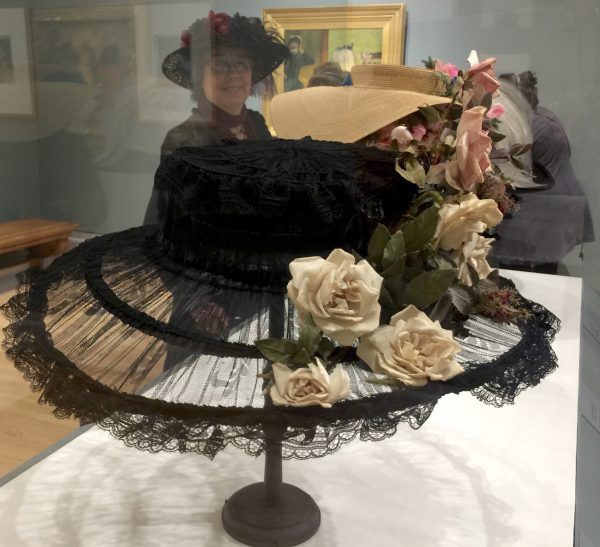 SAN FRANCISCO—Strangers stop my friend Kala in the street to admire her fancy headgear. “I love your hat. Where did you buy it?” they ask. You won’t find anything like it ready-made in a store. Each hat is her own creation and if you ask her why she wears hats, she’ll say, “life is too short to be boring.”
SAN FRANCISCO—Strangers stop my friend Kala in the street to admire her fancy headgear. “I love your hat. Where did you buy it?” they ask. You won’t find anything like it ready-made in a store. Each hat is her own creation and if you ask her why she wears hats, she’ll say, “life is too short to be boring.”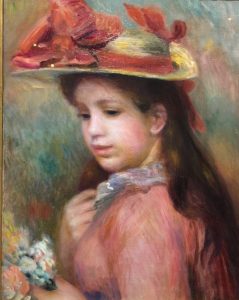
I lack the panache to wear a fancy hat and would cringe at the attention. But that’s not to say I couldn’t talk for hours about this optional accessory now that I’ve seen “Degas, Impressionism, and the Paris Millinery Trade” at the Legion of Honor. The exhibit opened my eyes to the role hats played in the life of the emerging modern woman.
The hat craze in nineteenth-century Paris turned milliners into millionaires. Scenes of proprietresses, shop girls, hat makers and customers cover four galleries along with forty hats from the era. 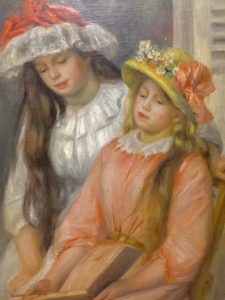
A Toulouse-Lautrec poster portrays a female motorcyclist in a straw boater with a black silk ribbon. A display case shows a horsewoman’s wool-felt bowler with a melon-shaped crown and pheasant plumage.
The major millinery houses lined rue de la Paix, place Vendôme and rue du Faubourg-Saint-Honoré. Passersby ogled the profusion of feathers, pleated velvet, bows and ribbons on the hat stands. The trade captivated Edgar Degas, Pierre-Auguste Renoir, Édouard Manet, Mary Cassatt and Henri de Toulouse-Lautrec.
Their paintings capture the playful, artistic, covetous and toxic aspects of the fashion trend. Renoir focused on girlhood innocence in his paintings of young girls in beribboned hats and white lace bonnets.
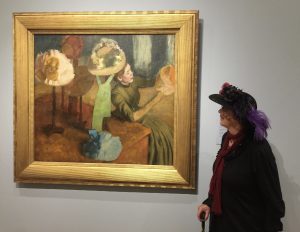 That summertime scene contrasts with James Tissot’s “The Shop Girl” and the cold-eyed appraisal of a top-hatted gentleman peering through the window at a shop girl. She ignores him, having given him the once-over and dismissed him as a flâneur. She deserved a better suitor; at least that’s what I read into her confident brisk return to matters at hand.
That summertime scene contrasts with James Tissot’s “The Shop Girl” and the cold-eyed appraisal of a top-hatted gentleman peering through the window at a shop girl. She ignores him, having given him the once-over and dismissed him as a flâneur. She deserved a better suitor; at least that’s what I read into her confident brisk return to matters at hand.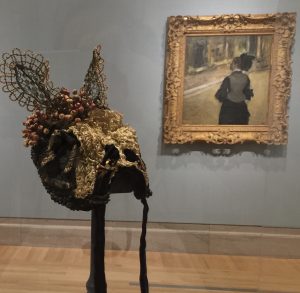
Women in the workforce unleashed the predators. “In the Wings” shows the hovering presence of a tuxedoed man next to a singer as she prepares to step onstage. Wealthy men could pay for elite access to the stage wings in order to interact with female performers, according to the wall panel.
Woman in the back of the shop had their own problems. At the height of the social season, millinery owners demanded 12- to 20-hour workdays. Hat designers also had to work harder to stay a step ahead of the competition.
A case shows two African starlings with iridescent blue feathers that were taxidermied and mounted on the narrow rim. In the pursuit of status, the rarer the decoration, the more desirable the hat. The outcry over the wanton destruction of exotic birds lead to the use of barn owls and pheasants.
 An hour later in the crowded gift shop, I tried on a cream straw hat with a tapered rim. I could feel the heat of everyone’s attention. My friend Kala stepped back, her eyes twinkling. “That hat is you. How much?” she asked.
An hour later in the crowded gift shop, I tried on a cream straw hat with a tapered rim. I could feel the heat of everyone’s attention. My friend Kala stepped back, her eyes twinkling. “That hat is you. How much?” she asked.
I fished for the price tag under the headband. “$195,” I said, my heart dropping. The exhibit seduced me into wanting a fancy hat. I would have brought it on the spot if I had a garden wedding to go to.
I put the lacy, floral confection back on the stand and sighed. If I still wanted it in a week’s time, I’ll succumb to my craving and buy the hat.
 —text and photography by Donna Peck
—text and photography by Donna Peck




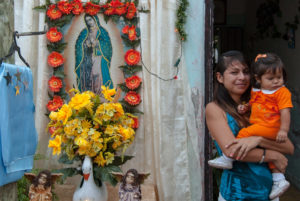

Leave a Reply